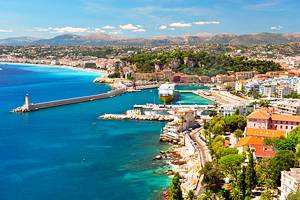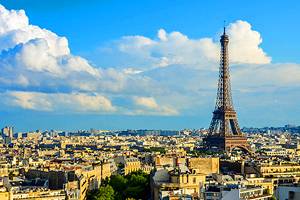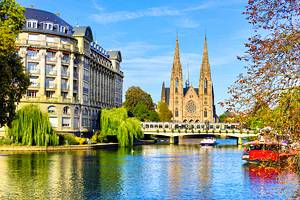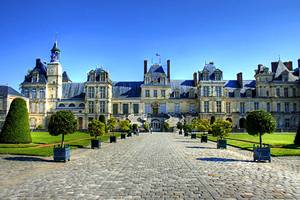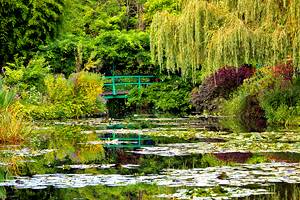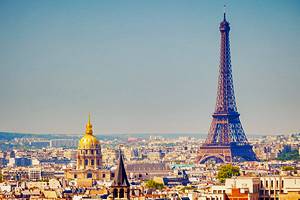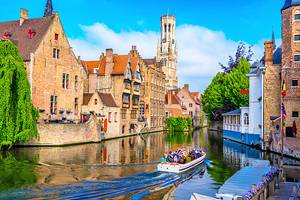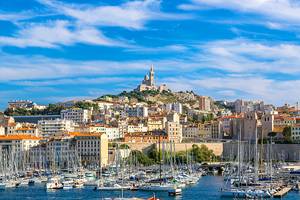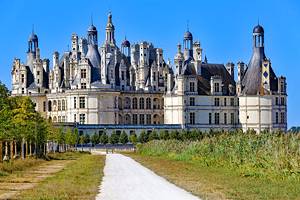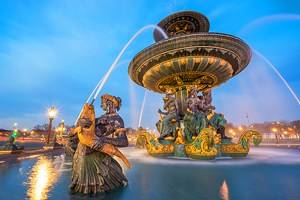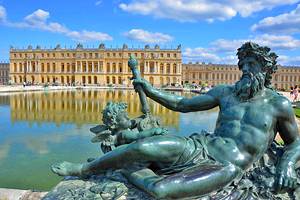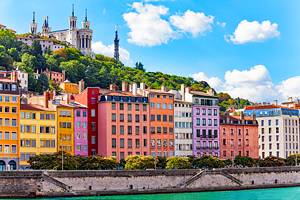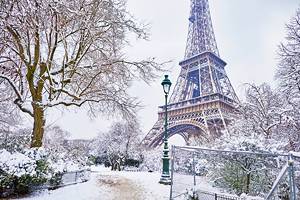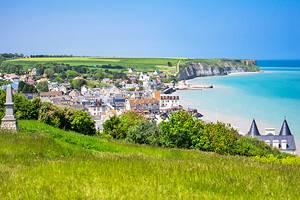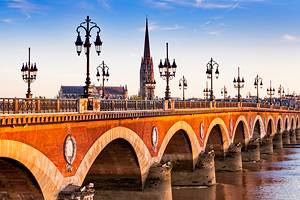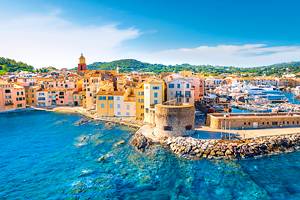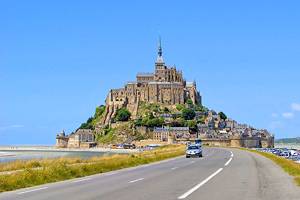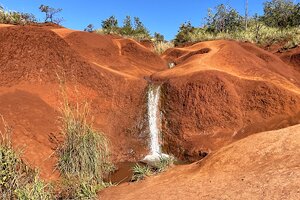Visiting Montmartre, Paris: Top 12 Attractions
Montmartre invites visitors to take a step back in time, while wandering its quaint cobblestone streets and relaxing in the leafy historic squares. This charming quarter (around Abbesses Métro station) represents the 18th arrondissement of Paris, but centuries ago, it was just a little hilltop village in the country. Today, Montmartre still feels a world apart from the rest of the city.
Thanks to its enchanting ambience, Montmartre has captivated Bohemian artists since the Belle Epoque and continues to delight tourists today. The special atmosphere and sense of joie de vivre burst from every corner of the neighborhood, from the old-fashioned merry-go-rounds and bustling sidewalk cafés to hidden pedestrian staircases and tree-shaded terraces where passersby can sometimes catch an impromptu street performance.
Tourists flock to the stunning Sacré-Coeur Basilica on the highest point of Mont Martyr, where the martyr Saint Denis was buried. The Sacré-Coeur may have a somber atmosphere inside the sanctuary, but outside, it's an exuberant celebration of life. Visitors snap photos; locals lounge on the grassy esplanade, and couples enjoy the romantic setting, as well as the splendid views.
A few steps away from the Sacré-Coeur are some of Montmartre's artistic highlights: the Place du Tertre, which is a veritable open-air gallery, and several museums displaying works by Renoir, Picasso, Dalí, and Toulouse Lautrec, who made this neighborhood an artists' colony.
It's worth taking time to wander the narrow, winding stone-paved lanes of Montmartre. A leisurely ramble might lead to discoveries of old churches, hidden squares, little bakeries, and inspirational ateliers.
This captivating neighborhood has so many tourist highlights that visitors could easily spend several days exploring the area. Learn about the best places to visit and things to do with our list of the top attractions in Montmartre.
- Basilique du Sacré-Coeur
- Place du Tertre and Eglise Saint-Pierre de Montmartre
- Musée de Montmartre
- Place des Abbesses
- Dalí Paris Museum
- Carré Roland Dorgelès
- Le Moulin de la Galette: Windmills
- Montmartre Cemetery
- Le Bateau Lavoir: A Famous Artists' Atelier
- Musée de la Vie Romantique
- Musée National Gustave Moreau
- Musée d'Art Naïf - Max Fourny
- Map of Montmartre, Paris: Top Attractions, Tours & Hotels
Basilique du Sacré-Coeur

The Sacré-Coeur Basilica is an important historical landmark, towering above Paris from high on the Butte Montmartre. The church was created after the Franco-Prussian War as a symbol of hope.
This Romanesque and Byzantine-style basilica has multiple domes (resembling a decorative layer cake), earning it the nickname of the "Wedding Cake."
Inside, the enormous Christ en Gloire (Christ in Glory) ceiling mosaic welcomes worshippers into the sanctuary. Dating to 1923, this 475-square-meter work of art is one of the world's largest mosaics.
Visitors are also enchanted by the abundance of candles in the dimly lit interior; the flickering illumination lends an aura of spirituality.
The basilica has a Grand Organ (listed as a Historical Monument), which is played on Fridays for Mass at 3pm, as well as on Sundays for Mass (at 11am, 6pm, 10pm) and Vespers service at 4pm. On Christmas Eve, there is an organ concert at 10pm prior to the Midnight Mass. Otherwise the Basilica du Sacré-Coeur is dedicated to silent prayer.

A highlight of visiting this famous attraction is the view from the Basilica's Dome, which requires an admission fee. In clear weather, it's possible to see the entire cityscape of Paris including the Notre-Dame, Centre Pompidou, and Opera House. Access to the Dome is outside the basilica on the left, up a flight of 300 steps (no elevator).
The Sacré-Coeur Esplanade (at the Parvis de la Basilique) also offers panoramic views. The esplanade is often filled with locals and tourists, and sometimes street musicians entertain the crowds.
Below the esplanade are the leafy gardens of the Place Louise-Michel, traversed by a staircase leading up to the basilica's entrance.
At the base of the Butte Montmartre (where the staircase begins) is the Place Saint-Pierre, a favorite spot for families because of its adorable old-fashioned carrousel.
To arrive at the Sacré-Coeur, tourists who don't mind an uphill climb can walk from Place du Tertre to 35 Rue du Chevalier-de-la-Barre (the entrance in the back of the Basilica).
Alternatively, from the Place Saint-Pierre, it's a scenic but steep 20-minute walk up 222 steps (through the verdant Place Louise-Michel) or a less than two-minute funicular ride that begins near the Place Suzanne Valadon, a short walk from the Place Saint-Pierre.
Address: 35 Rue du Chevalier-de-la-Barre, 75018 Paris
Official site: http://www.sacre-coeur-montmartre.com/english/
Place du Tertre and Eglise Saint-Pierre de Montmartre

The creative spirit of Montmartre comes alive at this picturesque square in the shadow of Sacré-Coeur. On the square's cobblestone courtyard space, local artists set up easels to create artworks on the spot. Many tourists are tempted to purchase the paintings, which often depict charming scenes of the neighborhood.
Visitors will find all kinds of painters, portraitists, and caricaturists, although much of the work is designed to be tourist souvenirs. The handsome 18th- and 19th-century buildings that enclose the square now house busy restaurants and cafés. Spilling out into the cobblestone square are outdoor terraces that allow tourists to soak up the scene.
Even when packed with tourists, the Place du Tertre does not lose its charm. Standing in the shadow of the Sacré-Coeur and shaded by ancient trees, the Place du Tertre has the feel of a provincial square. It was the main square of the medieval village before Montmartre became incorporated into Paris. The house at Number 3 on the square was the "Mairie" (town hall) of the old village. The narrow lanes surrounding the Place du Tertre invite visitors to explore.
For those interested in browsing or buying original art, the Galerie Montmartre is an exceptional venue. This prestigious gallery presents a wide range of modern and contemporary artworks, including pieces by famous modern artists Salvador Dalí, Joan Miró, Henri Matisse, and Pablo Picasso. The artwork at the Galerie Montmartre is authenticated and available for purchase.
A few steps away, behind the Place du Tertre, is the Paroisse Saint-Pierre de Montmartre at 2 Rue du Mont-Cenis. This church is the relic of a 12th-century Benedictine Abbey, however the history dates back further. The Church of Saint-Pierre was built on the site of a 7th-century (Merovingian era) house of worship, which was constructed over an ancient Roman temple dedicated to Mercury.
The interior of the Paroisse Saint-Pierre de Montmartre has retained features of the original Merovingian church, including the four black marble columns in the choir and at the west end of the nave. Besides its 7th-century vestiges, the Church of Saint-Pierre exemplifies Early Gothic architecture; the choir was consecrated in 1147 in the presence of the great Catholic reformer Bernard of Clairvaux. The interior also has contemporary stained-glass windows by Max Ingrand.
Musée de Montmartre

Discover the Bohemian past of Montmartre at this wonderful museum a few steps away from the Place du Tertre. Housed in a 17th-century building, the Musée du Montmartre offers a nostalgic view of earlier days in Montmartre.
The museum is the actual location of a meeting place that once attracted numerous artists. Auguste Renoir had his studio here, along with Suzanne Valadon and other artists including Émile Bernard and Raoul Dufy.
With its extensive collection of art dating back to the 1880s, the Montmartre Museum recounts the history of Montmartre and brings to life the creativity of this special quarter of Paris.
The collection of around 6,000 pieces includes the work of Montmartre's celebrated artists including Modigliani and Vuillard as well as the Nabis, Fauvist, and Symbolist painters. Among the famous works on display are the original posters for the Lapin Agile and Chat Noir cabarets. There is even a room devoted to art depicting the French Cancan dance.
The works of Toulouse-Lautrec are well-represented; his pastels truly capture the Bohemian spirit of Montmartre during the Belle Epoque. Toulouse-Lautrec would draw while attending a party or watching cancan dancers perform at the Moulin Rouge. Many of his works feature unconventional subjects such as clowns and cabaret dancers.
Surrounding the museum are the Renoir Gardens (Les Jardins Renoir), where the artist painted La Balancoire (The Swing) and the Jardin de la rue Cortot (The Garden of Cortot Street). The gardens offer sensational views of Montmartre and the rest of Paris.
In a corner of the garden, tourists will find Le Café Renoir, occupying the garden's beautiful glassed-roofed conservatory. This cheerful sun-filled space is a refreshing spot for enjoying coffee, snacks, light meals, and afternoon tea. The outdoor patio seating is especially pleasant during the spring and summertime.
Address: 12 Rue Cortot, 75018 Paris
Official site: www.museedemontmartre.fr
Place des Abbesses

The Place des Abbesses is a tree-shaded square featuring the prettiest Métro station in Paris. Its most renowned feature, the decorative Art Nouveau entrance was designed by Hectar Guimard. This bustling square is the center of Montmartre's social and commercial activity, with many shops, restaurants, and cafés on the nearby streets. There is also a musical carousel (merry-go-round) at the Place des Abbesses that children adore.
Visitors should note that the Abbesses Métro station is 30 meters underground and requires an arduous walk up a long winding staircase. Alternatively, visitors could arrive at the Pigalle Métro station, which does not have steep steps and is just a short walk from the Place des Abbesses.
Opposite the square is the Eglise Saint-Jean-l'Evangéliste (by Anatole de Baudot, 1904), a simple brick-faced church that serves the local community. Nearby streets of Rue Yvonne le Tac and Rue des Trois Frères are lined with cute cafés, boutiques, small neighborhood bakeries, and crêperies. Many restaurants in this area feature live entertainment, sometimes a classic accordion or jazz performance.

Taking a stroll through the meandering medieval streets of Montmartre is one of the most delightful things to do in Paris. For an off-the-beaten-path self-guided walking tour, tourists can begin at the Place des Abbesses and continue to the Passage des Abbesses. An arched entry provides access to a flight of steps that ascends the hill towards Rue Berthe.
Taking a right on Rue Berthe, a left on Rue Drevet, another left on Rue Gabrielle, and then a right on Rue du Calvaire leads up to the Place du Tertre. Lined with restaurants' outdoor dining terraces and filled with the easels of local artists, this lovely square is a favorite tourist spot. It's also just steps away from the Sacré-Coeur Basilica.
While walking around Montmartre, visitors will be charmed by the quiet traffic-free areas. Narrow cobblestone streets and pedestrian staircases reveal that Montmartre has roots as a small pastoral village (it was separate from Paris until 1860).
Glimpses of a bygone era are still found throughout Montmartre, seen in the clothes lines hung outside open-shuttered windows, in the tiny locally owned shops and corner boulangeries, and in the local way of life. Neighborhood residents linger at outdoor cafés, while kids play games of pick-up soccer in the squares.
Dalí Paris Museum

At this unique museum, visitors can delve into the curious and intriguing world of Salvador Dalí. Fittingly, the museum is located near the Place du Tertre, the center of Montmartre's art scene.
The Dalí Paris museum reveals the creative genius of the famous surrealist artist. This exceptional museum is the largest collection in France devoted to the work (paintings, sculptures, and graphics) of Salvador Dalí and is especially noteworthy for its assortment of the artist's sculptures.
Address: 11 Rue Poulbot, 75018 Paris
Official site: http://daliparis.com/en/
Carré Roland Dorgelès

This peaceful square hints at the atmosphere of Montmartre when it was a little provincial village. Shaded with ancient trees, the spacious square feels far away from the Parisian metropolitan area. At the corner of Rue Saint-Vincent and the steep street Rue des Saules is a historic house associated with the Bohemian artists of Montmartre.
Look for the wording "Au Lapin Agile" painted on the side of the building (22 Rue des Saules). This legendary establishment dates to 1860 and took its name "Lapin Agile" ("Agile Rabbit") from a poster painted by André Gill that depicted a rabbit jumping out of a cooking pot.
Montmartre's last remaining (and Paris' oldest) cabaret, Au Lapin Agile continues to share the joys of traditional French chansons with enthusiastic audiences. This small, cozy venue presents an artistic cabaret show "Songs, Music, Poetry," featuring Edith Piaf songs and old French songs. The audience may sing along, adding to the convivial experience.
At the turn-of-the-century, Le Lapin Agile and this area of Montmartre was the haunt of avant-garde artists, poets, writers, actors, and singers. Famous artists such as Toulouse-Lautrec, Claude Debussy, Vincent van Gogh, Pablo Picasso, Amedeo Modigliani, Max Jacob, and Guillaume Apollinaire gathered here, providing artistic inspiration to one another.
When wandering around the alluring old streets of the Carré Roland Dorgelès, visitors are transported to a scene of Montmartre's Bohemian past when the spirit of creativity flourished.
Le Moulin de la Galette: Windmills

The village of Montmartre was once graced with many windmills but they were all taken down except for two: the Moulin Blute-Fin and Moulin Radet, which date back to 1717. Together, these two remaining windmills are known as Le Moulin de la Galette, a nostalgic reminder of Montmartre's old windmills.
The Moulin de la Gallette provided inspiration for a number of painters including Renoir and Van Gogh. Renoir's famous masterpiece, Le Bal du Moulin de la Galette, shows a festive scene at a traditional ball that took place in 1876 at the Moulin de la Galette, seen in the painting's background. This celebrated Renoir masterpiece is found at the Musée d'Orsay.
Travelers can imagine the real-life scene of the Dance at Le Moulin de la Galette (captured by Renoir) by dining at the Le Moulin de la Galette restaurant (83 Rue Lepic). Specializing in seasonal French cuisine, this historic brasserie restaurant has a pleasant terrace with a view of the Moulin de la Galette windmills.
Also nearby is the La Galette des Moulins pâtissierie (1 Rue Norvins), a tempting boutique that offers classic French pastries such as eclairs, fruit tarts, and millefeuille (layers of puff pastry and cream).
Address: 83 Rue Lepic, 75018 Paris
Montmartre Cemetery

Opened in 1825, Montmartre Cemetery covers more than 11 hectares, the third largest in Paris and perhaps the most romantic, not only for its landscape but for the tombs, memorials, and chapels.
The cemetery's air of melancholy is intensified by the somewhat overgrown look of many of its monuments and by the poignant sculptures that adorn others.
Among the tombs are those of many of the artists who lived in Montmartre during its golden age. Visitors will find monuments to the painter Edgar Degas, the dancer and choreographer Vaslav Nijinsky, composers Jacques Offenbach and Hector Berlioz, writer Alexandre Dumas, and Marie Duplessis.
Le Bateau Lavoir: A Famous Artists' Atelier

Le Bateau Lavoir is a historic atelier where famous artists Pablo Picasso, Amedeo Modigliani, Kees van Dongen, Juan Gris, and Max Jacob lived and worked. In this unassuming little building that was once a piano factory, the art of Cubism was brought to life.
Picasso moved here in 1904 and a year later painted Les Demoiselles d'Avignon. This surprising and distinctive painting is the first example of Picasso's signature Cubist style.
Many artists, writers, actors, and art collectors (including Henri Matisse, Georges Braque, Gertrude Stein, and Jean Cocteau) also visited Le Bateau Lavoir to discuss art, which allowed new ideas to flourish.
In addition to the artists who visited and lived here, many noteworthy artists (including Paul Gauguin, Otto Freundlich, André Salmon, and Constantin Brancusi) had their studios here.
Back in those days, at the turn of the century, the house was rather squalid and had no electricity, heating, or running water, but it was very inexpensive, and the artists were happy living there because the cheap rent allowed for experimental creativity.
The atelier has since been rebuilt, replicating its original form, after being destroyed by a fire in the 1970s. However, only a small shopfront reveals the historic character of the original building that was home to a legendary artists' community.
Today the space houses 25 artists' studios. The Bateau-Lavoir is on the delightful tree-lined square, previously named Place Ravignan.
Address: 13 Place Emile-Goudeau, 75018 Paris
Musée de la Vie Romantique

This charming museum celebrates the Romantic era in Montmartre. Romanticism was an artistic movement (focused on imagination and expressiveness) that influenced the artists of Paris around 1815 to 1848.
During the 1830s, the Dutch painter Ary Scheffer turned his elegant villa, the Hôtel Scheffer-Renan, into a salon. George Sand, Frederic Chopin, Eugène Delacroix, Franz Liszt, Jean-Auguste-Dominique Ingres, Alphonse de Lamartine, and Ivan Turgenev were habitués of the salon.
The museum occupies the Hôtel Scheffer-Renan and evokes the historical ambience with period portraits, decor, and furniture. The collection comprises Beaux-Arts (Fine Arts) works and Arts Graphiques (Graphic Arts), which includes portraits and landscapes.
There is also a section devoted to Memorabilia with numerous mementos of the artists and literary figures who frequented the salon. Throughout the year, the museum hosts temporary exhibitions, guided walks, art workshops, and conferences.
Tucked away in the property's garden greenhouse, the museum's salon de thé (tea salon) serves light meals, afternoon tea, pastries, and snacks. The tea salon is open year-round. In inclement weather, the garden greenhouse provides an idyllic setting overlooking the tranquil, bucolic scenery. On warm sunny days, the outdoor patio feels like a little corner of paradise with its shady campanula trees and fragrant roses.
The museum is open Tuesday through Sunday from 10am until 6pm. The tea salon is open the same hours except that it closes at 5:30pm. Both the museum and tea salon are closed on Mondays, as well as on January 1st, May 1st, and December 25th.
Address: Hôtel Scheffer-Renan, 16 Rue Chaptal 75009 Paris
Official site: http://www.museevieromantique.paris.fr/en
Musée National Gustave Moreau

Bordering the Montmartre neighborhood in the 9th arrondissement, this museum is worth a detour for those who appreciate the art of Gustave Moreau. This museum was the residence and studio of Gustave Moreau from 1852 to 1898. The museum displays an extensive collection of Moreau's works, including around 1,300 paintings and 5,000 drawings.
Gustave Moreau was a Symbolist artist renowned for his romantic, whimsical, and fantastical style. Many of his paintings feature the theme of classical mythology, and others have a dreamlike quality. The museum has kept Moreau's cabinet de réception (study) in its original state.
Address: 14 Rue de La Rochefoucauld, 75009 Paris
Official site: https://en.musee-moreau.fr
Musée d'Art Naïf - Max Fourny

This innovative museum offers a more modern perspective of the Montmartre art scene, with a permanent collection of Max Fourny's artwork. The museum is at the foot of the Butte Montmartre in the Halle Saint-Pierre, a cultural center that opened in 1986. The building was originally designed as a marketplace but now is used as an exhibition center and a venue for cultural events.
Max Fourny is known for his naïve (folk) art, also called "art brut" ("raw art"). The collection includes more than 500 paintings and 80 sculptures. The museum at the Halle Saint-Pierre also features other exhibitions of folk art from around the world.
After viewing the artworks, visitors can stop at the bookshop and the café located within the Halle Saint-Pierre.
Address: Halle Saint-Pierre, 2 Rue Ronsard, 75018 Paris
Map of Montmartre, Paris: Top Attractions, Tours & Hotels
More Related Articles on PlanetWare.com
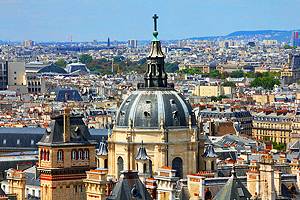
Exploring Bohemian Paris: By the late 19th century, Montmartre was an established gathering place for Bohemian artists such as Toulouse-Lautrec and Renoir. Montmartre continued to attract free-spirited artists through the Jazz Age and until the era of avant-garde art (Picasso and Dalí). At the same time, Bohemian artists and writers frequented other areas of Paris such as brasseries on the Boulevard Montparnasse and the sidewalk cafés of Boulevard Saint-Germain in the Latin Quarter. Similar to Montmartre, the Latin Quarter has an off-beat, artsy, and intellectual bent.
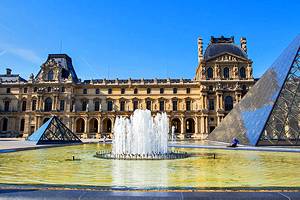
France for Art Lovers: Other destinations in France will appeal to travelers who love the artistic spirit of Montmartre. Tourists can begin by visiting the top museums in Paris to admire the works of the Impressionists and avant-garde artists who resided in Montmartre. Next on the artists' trail is the South of France. Many famous painters, such as Picasso, Van Gogh, and Cézanne, spent time in the Provence region and along the sunny Côte d'Azur (French Riviera); their work is on display at museums in Saint-Tropez, Saint-Rémy-de-Provence, Arles, and in Aix-en-Provence.


